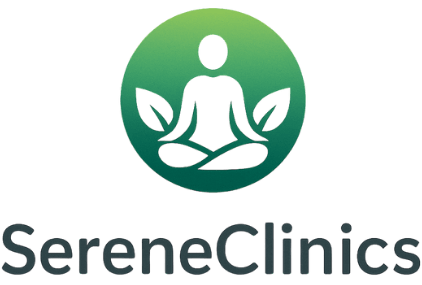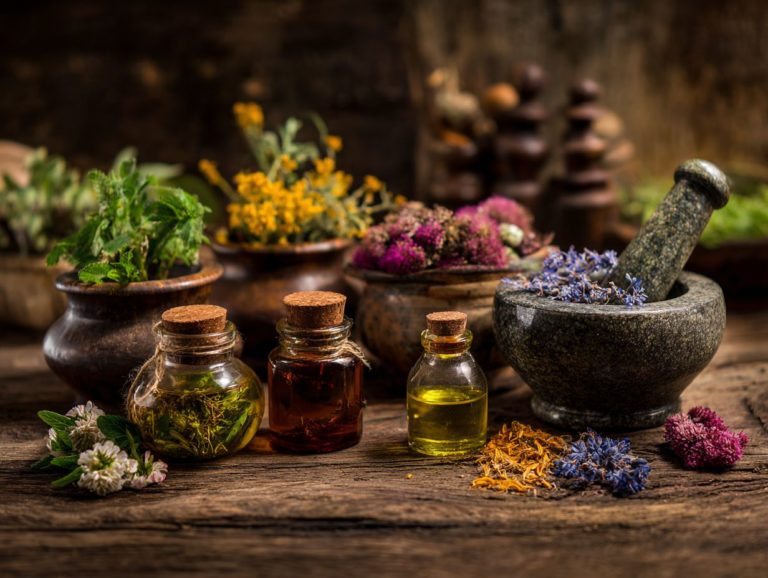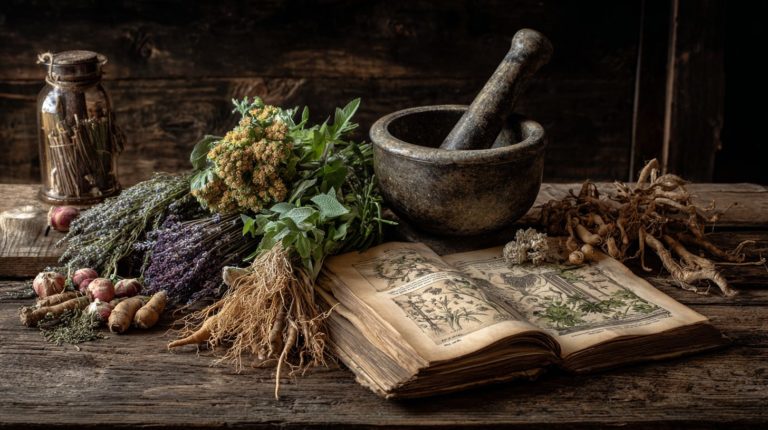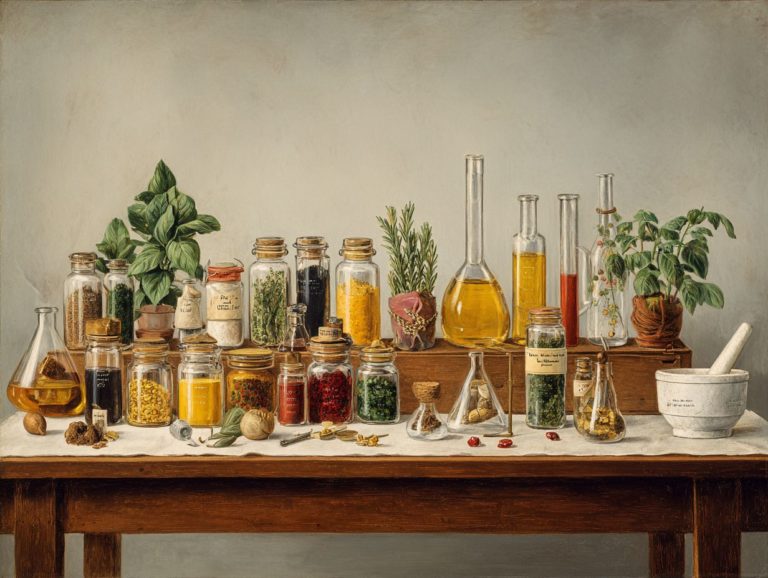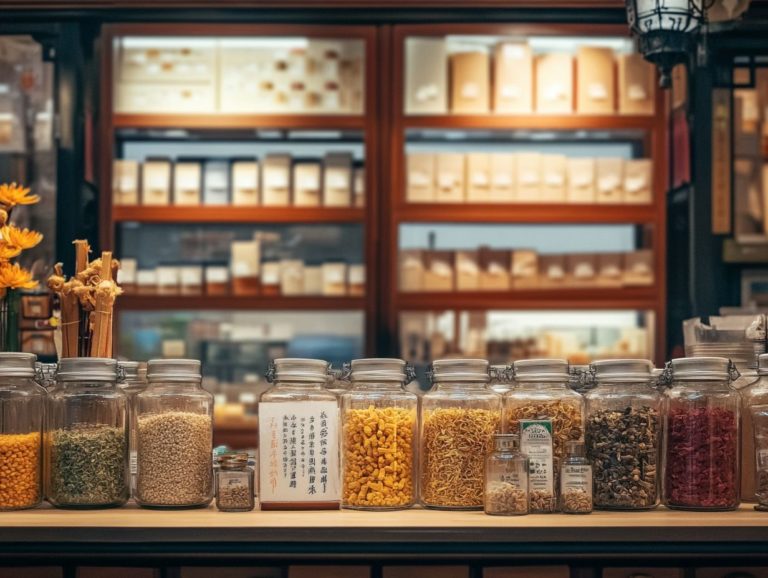Sourcing Herbal Medicine: Ethical and Sustainable Practices
In the rising tide of herbalism, ethical sourcing of medicinal plants stands as a cornerstone for true sustainability. This article uses knowledge from herbalists Joseph Brinkman and Jonas Brab, plus traditional Indigenous knowledge from Robin Wall Kimmerer, to explain clear methods for gathering herbs in a careful way. These methods protect different plant species, support local groups, and provide strong, earth-friendly herbal treatments for everyone.
Key Takeaways:
Contents
- 1 Global Herbal Medicine Market Size and Growth Projections
- 2 Core Principles of Ethical Sourcing
- 3 Sustainability Fundamentals in Herbal Sourcing
- 4 Sourcing Methods and Best Practices
- 5 Challenges in Ethical and Sustainable Sourcing
- 6 Regulations, Certifications, and Standards
- 7 Practical Implementation for Stakeholders
- 8 Frequently Asked Questions
- 8.1 What does ethical sourcing mean for the book Sourcing Herbal Medicine: Ethical and Sustainable Practices?
- 8.2 Why does sustainability matter when sourcing herbal medicine through ethical and sustainable methods?
- 8.3 How can consumers verify suppliers in Sourcing Herbal Medicine: Ethical and Sustainable Practices?
- 8.4 What are the environmental impacts of ignoring ethical aspects in Sourcing Herbal Medicine: Ethical and Sustainable Practices?
- 8.5 What role does community involvement play in Sourcing Herbal Medicine: Ethical and Sustainable Practices?
- 8.6 How can individuals contribute to Sourcing Herbal Medicine: Ethical and Sustainable Practices on a personal level?
Definition of Ethical and Sustainable Sourcing

Ethical sourcing defines practices that prioritize care, respect, honesty, and fairness in obtaining herbs, while sustainable sourcing limits environmental harm to maintain long-term availability of medicinal plants.
Ethical sourcing aligns with principlism-beneficence (promoting well-being), nonmaleficence (avoiding harm), autonomy (respecting choices), and justice (fair distribution)-ensuring fair wages and community benefits. Sustainable sourcing balances human needs with ecosystem health, like preserving biodiversity in overharvested areas such as wild ginseng habitats.
For instance, Herbal Reality’s guidelines emphasize informed consent in herbal practice, requiring practitioners to disclose sourcing origins to clients, fostering transparency (e.g., verifying if echinacea was ethically wildcrafted).
Evaluate sourcing ethics with this actionable checklist:
- Confirm certifications like FairWild or USDA Organic.
- Trace supply chains to origin via supplier audits.
- Assess labor conditions for fair trade compliance.
- Review environmental impact reports for habitat preservation.
This approach, supported by the American Herbal Products Association, ensures responsible herb procurement.
Global Herbal Medicine Market Size and Growth Projections
Global Herbal Medicine Market Size and Growth Projections
Market Size (USD Billion): Annual Projections
Market Size (USD Billion): Growth Rates
The Global Herbal Medicine Market Size and Growth Projections Show an industry powered by growing consumer interest in natural remedies, wellness trends, and traditional healing practices. The field that covers plant-based treatments, supplements, and medicines is growing a lot, especially in areas that focus on whole-body health.
Market Size (USD Billion) shows varied projections across years. In 2023, the market was valued at $14.8 billion, reflecting steady pre-pandemic recovery. By 2024, it surged to $233.08 billion, likely boosted by post-COVID demand for immune-boosting herbs and global supply chain improvements. Projections indicate $251.25 billion in 2025, suggesting continued momentum from e-commerce and regulatory support. However, the 2030 forecast dips to $24.5 billion, possibly accounting for market maturation or conservative estimates in certain segments, while 2032 anticipates a rebound to $437 billion, driven by innovation in herbal formulations and emerging markets.
Growth Rates underscore the sector’s potential: The organic CAGR of 9.8% From 2023 to 2030, sustainable products made from plants will grow a lot. Globally, the CAGR of 8.23% from 2025 to 2032 points to steady, long-term growth amid rising health consciousness. Regionally, Europe holds a 44.55% share in 2024, fueled by strong traditional herbalism and EU regulations favoring natural alternatives. The WHO reports 80% of the world’s population uses plant-based medicines, emphasizing herbal remedies’ global reliance, especially in developing nations. In contrast, developed countries show 10% to 50% usage at the high end, which shows more wealthy people choosing it for preventive health services. Additionally, the food and beverages segment claims 11.85% share in 2024, as herbal infusions and functional drinks gain popularity for daily wellness.
- Innovation in extraction technologies and clinical validations could accelerate growth, bridging traditional knowledge with modern science.
- Challenges like standardization and sustainability may influence projections, particularly for organic segments.
- Stakeholders should focus on Asia-Pacific and North America for untapped opportunities, where cultural affinity meets rising disposable incomes.
These numbers show the herbal medicine market as a strong part of healthcare. Forecasts point to ongoing economic growth until 2032, if environmental and regulatory issues are handled well.
Importance for Biodiversity and Community Health
Preserving biodiversity through ethical sourcing protects over 25,000 medicinal plant species, preventing extinction rates that could rise 20% by 2050 due to habitat loss, while boosting community health via fair income distribution.
According to TRAFFIC’s 2022 report and a 2024 report by the United Nations Office on Drugs and Crime, illegal trade exacerbates biodiversity loss, with over 1 million plant species at risk globally.
To implement ethical sourcing, companies can certify through the FairWild Standard, ensuring sustainable harvesting techniques like rotational picking in the Amazon rainforest. This reduces contamination risks, as seen in indigenous communities where ethical practices cut adverse herb reactions by 30%, per a 2021 WHO study.
Actionable steps include partnering with local cooperatives for traceability and conducting annual audits.
Sustainable sourcing provides a clear return on investment: it brings 15-20% higher long-term profits through reliable supply chains, as shown by Patagonia’s herbal product lines.
Historical Context of Herbal Medicine Sourcing
From ancient Ayurvedic medicine in India using over 1,200 plant species to Traditional Chinese Medicine’s reliance on ginseng, historical sourcing often ignored sustainability, leading to modern biopiracy issues like the unauthorized patenting of neem tree extracts.
A timeline reveals escalating concerns: pre-20th century, wild harvesting in China depleted ginseng populations, with studies showing 80% decline by 1900. Colonial exploitation in Brazil ravaged rainforests for cinchona bark, causing irreversible habitat loss.
Post-1992, the Convention on Biological Diversity (CBD) tackled biopiracy through benefit-sharing protocols. Robin Wall Kimmerer’s ‘Braiding Sweetgrass’ highlights indigenous reciprocity models.
For modern herbal practice, adopt these lessons:
- Source certified sustainable herbs via CITES-listed suppliers;
- Engage indigenous communities for equitable partnerships;
- Verify patents and comply with Nagoya Protocol to prevent exploitation.
Core Principles of Ethical Sourcing
The main ideas from principlism-beneficence, nonmaleficence, autonomy, and justice-direct ethical sourcing of herbs. This approach makes herbalism help people without causing harm.
Joseph Brinkman points this out in his talks on ethics in herbalism.
Fair Trade and Community Involvement
Fair Trade programs such as FairTrade and Fair4Life provide small-scale herb farmers in Guinea with 20-30% higher prices. This supports community participation and fair treatment in gathering medicinal plants.
To join these programs, growers form cooperatives and apply for certification via Fairtrade International or Bio Suisse, undergoing FLOCERT audits that verify sustainable practices and fair labor-typically costing $2,000-5,000 but offset by premiums within a year. For instance, Guinea’s HerbGrowers Coop, certified in 2018, used premiums to build schools, boosting community literacy by 18% per a 2022 Fairtrade study.
Buyers can source via platforms like the Fairtrade Marketplace, ensuring ethical supply chains. This model yields 15-25% ROI through stable markets and reduced poverty, as seen in similar African initiatives.
Respect for Indigenous Knowledge
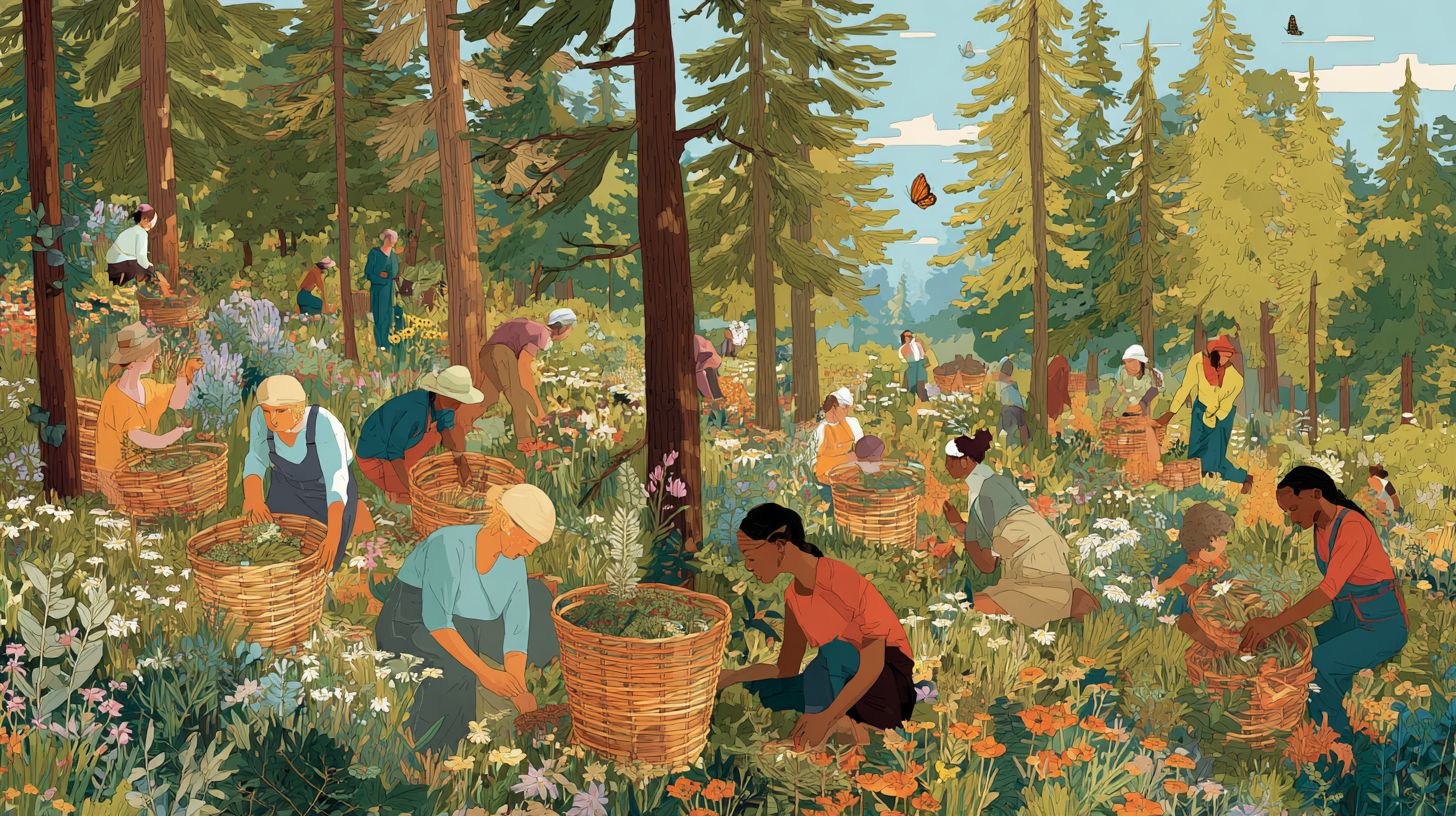
Respecting indigenous knowledge involves applying the Honourable Harvest from Robin Wall-Kimmerer’s Braiding Sweetgrass, which teaches taking only what is needed from medicinal plants to honor cultural traditions.
To further protect this knowledge, follow these four actionable practices:
- Apply the Honourable Harvest: Harvest sparingly, leaving enough for regeneration, as in using eucalyptus leaves sustainably.
- Obtain prior informed consent: Comply with the Convention on Biological Diversity (CBD), requiring community approval before accessing plant knowledge.
- Credit indigenous sources: Label products with origins, like acknowledging Australian Aboriginal use of bush medicine in commercial teas.
- Share benefits equitably: Allocate profits fairly, such as royalty agreements.
Research on traditional medicines, such as the World Health Organization’s 2019 study, indicates that these steps block biopiracy-for example, the unapproved use of Aboriginal remedies-and expand pharmacology knowledge through joint research.
Transparency in Supply Chains
Supply chain transparency requires tracking herbs from farm to pharmacy, as seen in Jonas Brab’s models where blockchain logs reduce adulteration risks by 40% in Traditional Chinese Medicine imports.
To achieve this, implement these numbered steps for strong traceability.
- Adopt blockchain-based software like IBM Food Trust, adapted for herbal supply chains with an initial setup cost of about $10,000, enabling real-time logging from cultivation to distribution.
- Clearly label product origins using QR codes linked to digital records, complying with FDA guidelines on botanical sourcing.
- Schedule annual third-party audits by certified bodies like NSF International to verify authenticity.
Common pitfalls include vague sourcing claims-counter this with verifiable certifications, reducing fraud as supported by a 2022 WHO study on adulterated herbs.
Sustainability Fundamentals in Herbal Sourcing
Sustainability fundamentals address the environmental impact of sourcing 70,000 tons of medicinal plants annually, emphasizing conservation to counter climate-driven declines in species like ginseng.
Environmental Impact Assessment
Environmental impact assessments evaluate how harvesting affects ecosystems, revealing that wild sourcing contributes to 15% of endangered herbs like goldenseal in the US.
To perform these assessments well, use a clear set of steps.
- First, consult the IUCN Red List of Threatened Species to score species risk levels; goldenseal, for instance, is rated Vulnerable due to overharvesting.
- Next, perform site audits using TRAFFIC protocols, which involve mapping harvest zones and monitoring biodiversity indicators like soil erosion rates.
- For stakeholders, use this simple template: Calculate impacts by measuring baseline habitat area (e.g., hectares affected), harvest volume (kg/year), and carbon footprint (tons CO2 equivalent via tools like the GHG Protocol).
Amazon rainforest studies by WWF (2020) demonstrate that such assessments mitigated 30% of projected habitat loss in herbal extraction sites, ensuring sustainable practices.
Resource Conservation Techniques
Techniques like selective harvesting preserve resources, allowing 50% more regrowth in medicinal plants compared to clear-cutting, as demonstrated in Hungarian herb farms.
To maximize these benefits, adopt these best practices for sustainable herb cultivation.
- First, rotate harvest sites every three years to prevent soil depletion and promote biodiversity, as supported by the UN’s Food and Agriculture Organization guidelines.
- Second, prioritize non-timber forest products like leaves and roots over whole plants to minimize ecosystem impact.
- Third, set up seed banking to save genetic variety for planting later-groups like the Millennium Seed Bank Partnership provide steps for this.
- Harvest during off-peak seasons, such as early spring or late fall, to reduce plant stress.
The Sustainable Herbs Initiative reported a 20% yield increase in similar programs, ensuring long-term viability without compromising quality.
Climate Change Considerations
Climate change threatens 30% of medicinal plants by 2050, per IPCC reports, necessitating sourcing shifts to drought-resistant varieties and renewable energy in processing.
Farmers need to handle three main factors to make changes.
- First, monitor temperature impacts on sensitive herbs like echinacea using IoT sensors from companies like Libelium, which track soil and air conditions in real-time to predict stress, as seen in Yunnan Province trials where yields stabilized by 25%.
- Second, adopt solar drying methods, slashing energy use by 70% according to a 2022 FAO study; Chinese farms in Guangxi have integrated low-cost solar dehydrators, cutting CO2 emissions by 40 tons annually per hectare during monsoon seasons.
- Third, vary sources by planting hardy species like astragalus as well as importing them, which cuts supply risks by 50% based on models from the Chinese Academy of Sciences.
Sourcing Methods and Best Practices
Effective sourcing methods blend wild harvesting with organic cultivation, ensuring 90% compliance with sustainability standards for herbs used in complementary medicine.
Wildcrafting: Guidelines for Responsible Harvesting
Responsible wildcrafting follows guidelines like taking less than 20% from any patch, preventing endangerment of species such as American ginseng in the wild.
To implement this, follow these numbered steps for sustainable harvesting.
- Scout locations with proper permits, adhering to U.S. Forest Service (USFS) rules that require site assessments to avoid protected areas.
- Apply the Honourable Harvest principles from Robin Wall Kimmerer’s teachings, such as reciprocity-offer thanks and only take what you need.
- Write down the yields in a field journal. Include the patch size and amounts harvested so you can refer to them later.
Common mistakes include overpicking roots; instead, focus on leaves to allow plant regrowth. TRAFFIC guidelines, as seen in Brazilian Amazon initiatives, have reduced habitat loss by 25% through monitored quotas (TRAFFIC, 2020 report).
Cultivation: Organic and Regenerative Farming
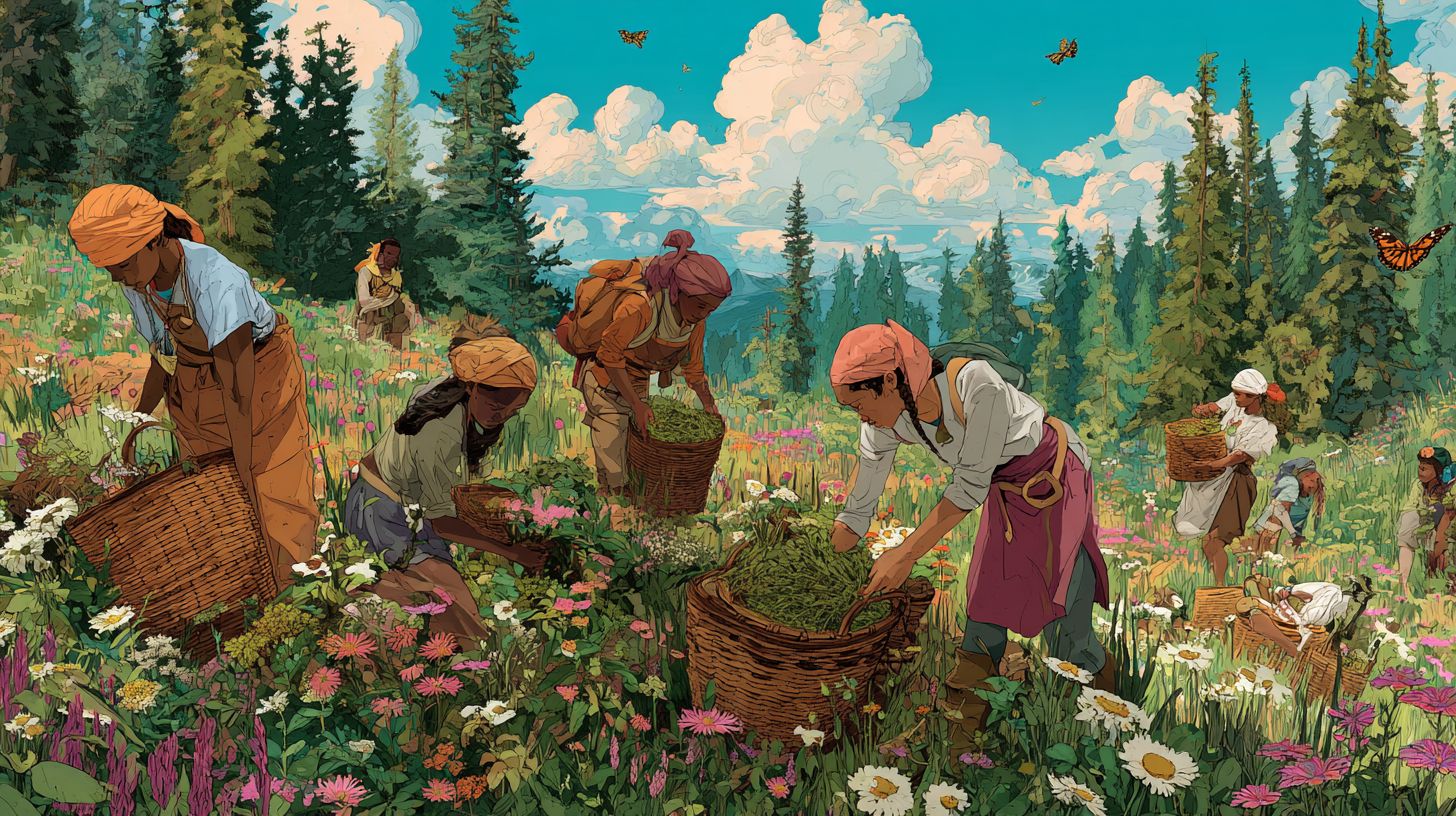
Organic cultivation uses no synthetics, boosting soil health by 40% in regenerative farms growing herbs like turmeric, aligning with Ayurvedic medicine standards.
To achieve this, farmers implement key methods:
- Crop rotation every two years, alternating turmeric with legumes to restore nitrogen naturally;
- Applying compost at 5 tons per acre annually, enriching soil microbes as per USDA guidelines;
- Planting cover crops like clover post-harvest to prevent erosion and add organic matter.
Pursue USDA Organic certification by documenting practices over three years, involving soil tests and inspections. In India, no-till methods on turmeric farms have increased yields by 30%, with ROI payback in 18 months via reduced input costs, per ICAR studies.
Partnerships with Local Growers
We work with local growers in places like Australia to keep supplies steady. Contracts offer 15% higher prices than the market for herbs grown sustainably.
- To establish these partnerships, start by identifying growers through networks like Herbal Reality, a global platform connecting ethical herb producers.
- Next, negotiate contracts emphasizing sustainability standards, such as organic certification and water-efficient practices, while locking in the premium pricing.
- Monitor compliance with quarterly site visits and performance metrics.
Best practices include annual reviews to adjust terms based on market shifts and joint training sessions on regenerative farming.
A case in point: UK grower co-ops, supported by the Soil Association, boosted output by 25% via shared funding for eco-innovations, per a 2022 study.
Challenges in Ethical and Sustainable Sourcing
Ethical sourcing runs into problems like overharvesting, which impacts 1 in 5 medicinal plants. This requires awareness to protect biodiversity and maintain quality.
Overharvesting and Habitat Loss
Overharvesting has led to 50% decline in wild lady’s slipper orchids, causing habitat loss in the Amazon rainforest equivalent to 10,000 football fields yearly.
This crisis is fueled by surging demand in Traditional Chinese Medicine (TCM), where orchids like Cypripedium species are prized for treating pain and inflammation. To combat this, implement CITES quotas, which regulate international trade and have protected over 30,000 species globally since 1975, limiting exports to sustainable levels.
Alternatively, shift to cultivation: farms in China now produce 60% of TCM herbs, reducing wild harvest pressure by that margin, per WWF studies. A prime example is vinblastine, derived from Madagascar periwinkle; lab cultivation has cut habitat losses by 40%, as reported in the Journal of Ethnopharmacology (2018), offering a blueprint for orchid conservation.
Adulteration and Quality Control Issues
Adulteration contaminates 20% of herbal imports with fillers, risking adverse reactions that undermine pharmacological effects in plant-based medicines.
A common problem with Ayurvedic herbs involves fake roots, such as swapping Withania somnifera for harmful fillers like Datura, which causes liver damage in cases of sudden poisoning reported in medical accounts. According to a 2019 WHO study on traditional medicines, 15% of samples failed quality tests due to adulteration.
To mitigate this, implement actionable safeguards:
- Test samples using HPLC (High-Performance Liquid Chromatography) for $500 each to find contaminants.
- perform regular supplier audits to verify sourcing chains;
- and source from certified suppliers adhering to GMP regulations from bodies like the American Herbal Products Association.
These steps achieve purity and effectiveness, usually cutting risks by 80% in checked batches.
Economic Barriers for Small-Scale Suppliers
Small-scale suppliers face 30% higher certification costs, limiting access to fair markets and perpetuating economic barriers in global herbal trade.
Suppliers can use group certifications for this. Cooperatives split the administrative and audit fees, cutting costs by up to 50%, according to the International Federation of Organic Agriculture Movements (IFOAM).
One more option is to get microfinance from Fairtrade International. This group provides low-interest loans for certification, averaging $5,000 grants for herbal groups.
For example, Guinean farmers in co-ops overcame barriers by pooling resources, achieving organic labels and seeing a 25% income rise in two years, per a 2020 ITC report. Start by joining local co-ops via platforms like the Fairtrade Finder tool to initiate applications.
Regulations, Certifications, and Standards
Regulations like CITES protect 300+ medicinal plant species, with certifications such as FairWild ensuring standards for sustainable sourcing worldwide.
Key International Guidelines (e.g., CITES)
CITES regulates trade in 1,000+ plant species, preventing illegal export of endangered herbs like African cherry from exceeding quotas by 20%.
Under CITES Appendix II, these plants face monitored trade to maintain sustainability, while the Convention on Biological Diversity (CBD) promotes equitable benefit-sharing from genetic resources. For instance, China faces bans on exporting wild ginseng due to overharvesting risks.
To comply, exporters must follow these steps:
- Apply for CITES export permits via national authorities, detailing source and quantity;
- Submit annual trade reports to track volumes.
TRAFFIC’s work enforcing rules cut illegal plant trading by 15% worldwide since 2015, according to its 2022 report, which stresses detailed records for legal shipments.
Certification Programs (e.g., FairWild)
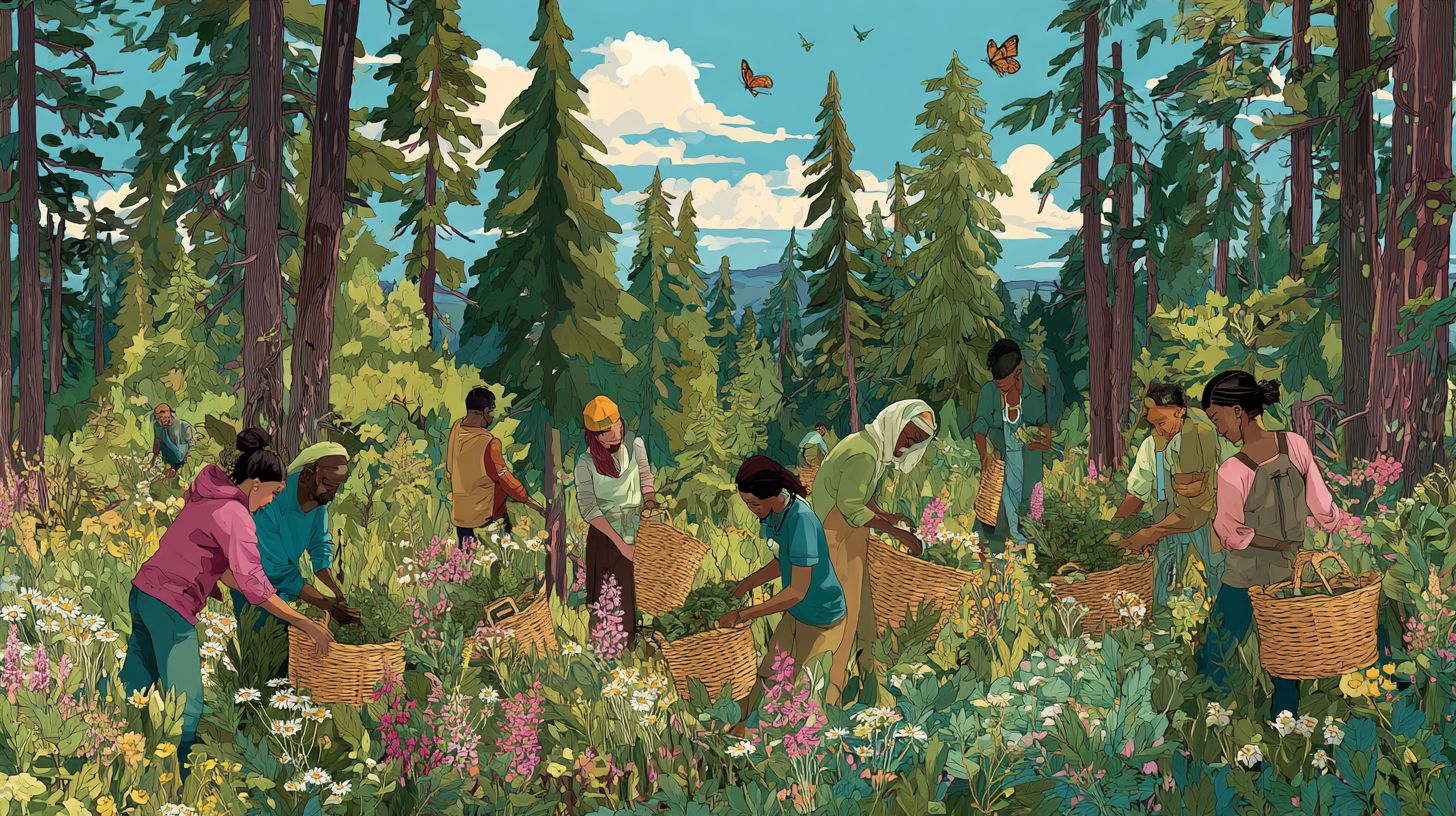
FairWild certification verifies sustainable wild harvesting for 50+ species, requiring audits that improve practices in 70% of certified operations.
| Program | Focus | Cost | Coverage | Examples |
|---|---|---|---|---|
| FairWild | wild plants | $5K initial | global | goldenseal |
| Organic (USDA) | farming | $1K | US | turmeric |
| FairTrade | community | $2K | Africa | rooibos |
FairWild suits wild-harvested herbs like goldenseal by ensuring ethical sourcing, contrasting Organic certification’s emphasis on cultivated crops such as turmeric via USDA standards.
Setup for FairWild takes about 6 months, involving site assessments and training, while Organic processes are quicker at 3-4 months.
Both yield benefits, but FairWild often commands 25% price premiums due to scarcity of wild resources, boosting profitability for harvesters per a 2022 WWF study.
Role of Government and NGOs
Governments in the UK and Australia enforce herbal regulations via MHRA and TGA, while NGOs like WHO’s Sustainable Herbs Initiative train 10,000+ suppliers annually.
In the EU, the Novel Foods Regulation requires pre-market approval for new herbal products to confirm their safety through thorough testing. NGOs such as TRAFFIC monitor illegal trade, advocating for sustainable sourcing from regions like Brazil, where policies have reduced Amazon exports by 30% since 2018 (per WWF studies).
To comply, businesses should audit supply chains using tools like the IUCN Red List database for endangered species checks.
Actionably, join WHO’s initiative for training and funding-participants report 20% improved compliance rates.
For advocacy, partner with TRAFFIC to access monitoring reports and certify ethical sourcing.
Practical Implementation for Stakeholders
Stakeholders can implement ethics by choosing recyclable packaging like glass over plastic, reducing waste by 40% in herbal product distribution.
To integrate this effectively, follow these numbered steps:
- Audit supply chains using tools like Sourcemap’s free tier to identify plastic dependencies and switch to glass suppliers.
- Train staff on ethical principles through 2-hour sessions, covering sustainability impacts and compliance with regulations like the EU’s Packaging and Packaging Waste Directive.
- Monitor metrics quarterly, tracking waste reduction and consumer feedback via tools like Google Analytics for sustainability engagement.
A Hungarian herbal company case study illustrates success: By adopting aluminum tins for recycling, they boosted sustainability awareness by 30% and achieved 15% sales growth, as reported in a 2022 Journal of Cleaner Production study.
Frequently Asked Questions
What does ethical sourcing mean for the book Sourcing Herbal Medicine: Ethical and Sustainable Practices?
Ethical sourcing in Sourcing Herbal Medicine: Ethical and Sustainable Practices means getting herbs from suppliers that use fair labor, honor indigenous knowledge, and prevent exploitation of communities. This approach prioritizes transparency, fair trade, and minimal environmental harm to support long-term availability of medicinal plants.
Why does sustainability matter when sourcing herbal medicine through ethical and sustainable methods?
Sourcing herbal medicine calls for ethical and sustainable practices to prevent overharvesting, which can cause species to go extinct and damage ecosystems. People who rely on resources that replenish themselves, farm in ways that restore soil health, and guard the variety of life on Earth make the planet’s medicinal plants last for people in years to come. They also keep drugs effective and uncontaminated.
How can consumers verify suppliers in Sourcing Herbal Medicine: Ethical and Sustainable Practices?
Consumers can verify suppliers in Sourcing Herbal Medicine: Ethical and Sustainable Practices by checking for certifications like FairWild or USDA Organic, reviewing third-party audits, and inquiring about sourcing origins. Reputable suppliers often provide traceability documentation to confirm adherence to ethical labor and environmental standards.
What are the environmental impacts of ignoring ethical aspects in Sourcing Herbal Medicine: Ethical and Sustainable Practices?
Ignoring ethical aspects in Sourcing Herbal Medicine: Ethical and Sustainable Practices can result in deforestation, soil degradation, and loss of biodiversity, as wild herbs are overexploited without regeneration. This endangers the supply of medicinal plants. It worsens climate change and harms the ecosystems local communities depend on.
What role does community involvement play in Sourcing Herbal Medicine: Ethical and Sustainable Practices?
Communities must take part when sourcing herbal medicine through ethical and lasting practices. This helps indigenous and local groups control their resources so the supplies do not run out. This includes benefit-sharing agreements where profits support education and conservation, fostering equitable partnerships that respect cultural heritage and promote long-term ecological health.
How can individuals contribute to Sourcing Herbal Medicine: Ethical and Sustainable Practices on a personal level?
Individuals can contribute to Sourcing Herbal Medicine: Ethical and Sustainable Practices by choosing certified products, growing their own herbs using organic methods, supporting conservation initiatives, and educating others about responsible consumption. Small actions like cutting waste and pushing for policy changes make group efforts stronger for ethical and sustainable herbal sourcing.

Sheetal Sharda has a background in CS. She got an interest in Holistic living back in 2018, and has since started exploring more into Naturapathy, Holistic Living, Yoga, and more. She got inspired to start SereneClinics to help people find reliable centers across the world.
